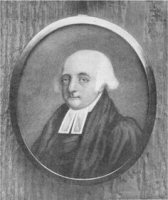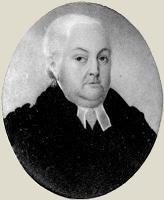|
The Rectors of Esher
|
Before Christ Church was built in 1854 Esher had had about 33 rectors, the first recorded in 1280. We know little about these men and
records of this period mainly deal with disputes rather than deeds of kindness, hard work or self-sacrifice.
|
|
In the 13th and 14th centuries rectors were in the main appointed by the Lord of the Manor often providing income for a younger son.
They collected the revenues of the parish Church, as the monasteries had done. Most of the professional classes were supported in this way,
receiving their income from the parish levies without the necessity of living in the parish or preaching regularly in the Church.
The parish business in Esher was conducted by two clerks, the rector paying one and the parishioners the other - a tithe of young calves and the
tenth penny from the tradesman.
|
|
With one exception, it was not until 1747 that the parish had a rector who lived in Esher and who preached every week. In the Middle Ages
most of the everyday pastoral care in a country parish was carried out by the curates of whom we know nothing at all; not even their names.
These curates and priests lived on the small tithe of local food and fees in connection with marriages and burials.
|
|
The rector owned some of the Church plate and there was a lot of wrangling when in 1308 the Church goods were stolen and the question arose
whose duty it was to replace them; the rector Thomas de Maidstone or the parish. Thereafter, all the valuables were kept in a locked,
wooden chest. Such a chest stands in St George’s. It has three locks whose keys were held separately by the rector and two church
wardens. The 18th century chest is in the Christ Church choir vestry. Thomas was followed by Roger de Lovekyn of the Kingston family
associated with the eponymous Chapel.
|
|
The records for the 15th century are missing. During that period Sandon (Sandown) Priory was united with St Thomas’ Southwark and the Bishop’s
chapel at Esher Place was no longer used by the parish. St George’s church was the only surviving, active institution.
|
|
After the rebuilding of the church in 1548 there was a curate, Roger Salisbury and then Mr Thomas Hooker arrived in 1620. He was to become a
Father of the Connecticut Constitution, the basis of the American Constitution. Francis Drake of Esher Place, a relation of the famous Sir Francis,
asked Thomas Hooker to accept the living and to lodge at the Manor house so that he could also minister to his sick wife. Mrs Drake suffered
from melancholia and believed she had committed the ‘unpardonable sin’ and was destined to perdition. He had no success and left the parish
in 1626, having married Mrs Drake’s waiting maid. In 1630 he was cited for Nonconformity by Laud’s Commission, and eventually sailed for
New England in 1633.
|
|
In 1636 Charles I granted the Rectory to the Rev Michael Hudson, his chaplain at Oxford. It is doubtful if he had much to do with Esher
personally except to receive the revenues. A zealous ‘Royalist Divine’ he was captured at Newark with Charles in 1646, escaped and was
recaptured and sent to the Tower. He escaped again, promoted a Royalist rising and died defending Woodcroft, Northamptonshire.
|
|
With the Rev Thomas Blechynden in place, Archbishop Laud ordered parish churches to put rails around altars in 1640. In Esher the
Churchwarden, the sexton and several parishioners were dissatisfied with this, opposed the Rector and removed the rails forcibly.
|
|
The next incumbent, Benjamin Spencer met similar opposition when he delivered fundamentalist Anglican sermons of a violent and denunciatory
style. After the Restoration, militancy was relaxed and soon Esher had its very own ‘Vicar of Bray’. Edward Sclater was a devoted
Royalist and Anglican who then turned Roman Catholic. He recanted in 1688 and returned to the Church of England.
|
|
William Barnard, rector from 1726, left to become the Bishop of Raphoe and later, Derry. He is buried in Westminster Abbey. However,
his successor Floyer Sydenham died in the debtors prison at 77. He was an excellent classics scholar and had been called to the Bar.
The sympathy aroused by his death led to the formation of the Royal Literary Fund to assist deserving authors.
|
|
Appointed in 1747, John Gould Floyer, cousin of John Latton, Lord of the Manor of Esher Place, was Rector for thirty years. Living in what
is now called The Lammas, he had the merit of being the first Esher Rector to live on his benefice and to preach every Sunday. He frequently
repeated his sermons, several written by his young brother and one being delivered no less than 22 times. However, he drew crowds to hear him
and on one occasion the congregation included the Duke of Newcastle, the Post Master General, the Bishop of Salisbury and the Canon of Windsor.
|
|
For fifty-one years from 1777, Wadham Diggle (left - click on photo to enlarge) was rector of Esher. By the time Princess Charlotte was at Claremont he was 74 and ‘infirm,
very deaf, and indistinct in his utterance.’
|

|
Wadham Harbin (right - click on photo to enlarge) succeeded him in 1828. He was not resident in Esher but we know from Queen Victoria’s
diaries that he regularly preached very long sermons. A new rectory was built on the site now occupied by Lloyd’s Bank and it was at Harbin’s
instigation and with his support that Christ Church was built and opened in 1854.
|

|